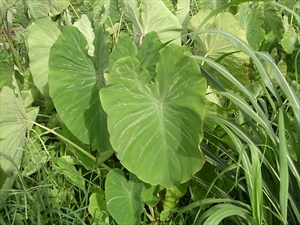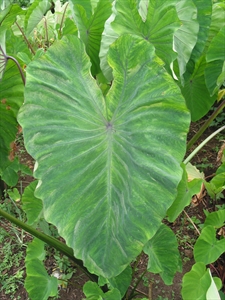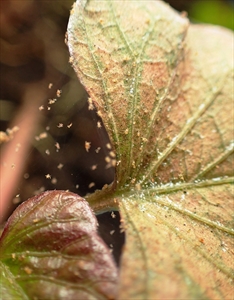Spider mites
Pacific Pests, Pathogens and Weeds - Online edition
Pacific Pests, Pathogens & Weeds
Spider mites (024)
Tetranychus species. The different species are difficult to tell apart; they need to be examined using a high power microscope. The two-spotted mite (Tetranychus urticae), also known as the red spider mite, is common in Pacific island countries, infesting over 200 species of plants. This fact sheet mostly concerns this species.
In the tropics and sub-tropics.
Many crops are host to spider mites in Pacific Island countries, among them cassava, okra, papaya, sweetpotato, tomato, eggplant, beans, taro, bele, cucumber, squash and other cucurbits. Many ornamentals and weeds are also hosts.
Spider mites are common plant pests. They have needle-like mouthparts and use them to suck juice from the leaves. This destroys the cells, and the leaves show a characteristic white to pale yellow speckling, often along the sides of the main veins (Photos 1-3). When infestations are severe, the speckling is seen all over the leaf.
Two-spotted mites make webs (like spiders) on the under surface of leaves, and on the upper surface when infestations occur in screenhouses where infestations are often high, and they are less likely to be washed off (Photo 4). As the infestation advances, the leaves turn yellow and die prematurely.
The eggs are round and relatively large in comparison to the size of the adult; they are laid in the webbing near the veins, on the underside of leaves.
Each female lays about 100 eggs during a lifetime. The eggs hatch in about 3 days, producing larvae that have six legs and are colourless. From these, nymphs develop, which have eight legs; they moult once and within a few days become adult. The adults are about 0.5 mm long, with males smaller than females, and narrower towards the back end (Photo 5). Two-spotted mites vary from light yellow to dark green or brown.
Under tropical conditions the life cycle takes only 7-10 days depending on temperatures. Populations develop rapidly, especially during periods of drought when damage can be considerable (Photos 6&7). The adults live for 2-4 weeks.
Mites produce fine silken webs - from a pair of glands near the mouth. When infestations are high, this webbing covers all or part of the leaf and becomes very noticeable (Photo 9). The webs allow the mites to travel from infested to non-infested leaves; also, the webs are caught by the wind and help the mites disperse.
The extent of the damage caused by mites often depends on rainfall. When rainfall is low, mite populations are high and reduce crop yields. On taro, for instance, yellowing and early maturity of plants occurs and corm size is reduced. Damage is particularly severe during droughts and, presumably, outbreaks will increase with climate change.
Look at the underside of leaves, particularly near the veins for the presence of mites, using a hand lens and/or a microscope. Look for webbing, which can be seen when mites are present in large numbers. The white spots on the upper leaf surface and the presence of webs below are signs of their presence. Look for spots on the mites; the spots are reddish-brown to yellowish-green, depending on the species.
A good way to detect if mites are present is to place a sheet of white paper beneath the leaves and strike the leaves sharply. The mites fall onto the paper and can be more easily seen than on the green leaves.
An IPM APPROACH
An integrated pest management approach is needed to control tomato red spider mite. This involves crop hygiene through culling of nightshade and other Solanaceae weed hosts from the crop area and surrounds, encouragement of natural enemies, and if required (registered) miticides.
NATURAL ENEMIES
Predatory mites keep populations of spider mites in check, such as do ladybird beetles (see Fact Sheet no. 083), lacewing larvae (see Fact Sheet nos. 270&406), pirate bugs, big-eyed bugs (see Fact Sheet no. 370), and predatory thrips. Managing mites requires preserving natural enemies; in most cases this means doing nothing to harm them. It also means not using pesticides.
CULTURAL CONTROL
Before planting:
- Weed in and around nurseries, especially remove wild plants, e.g., nightshades and Amaranthus.
- Check plants in the nursery for mite infestations, and if pressent do not plant in the field. Spray any infested plants (see below), or source propagating stocks from a reputable supplier.
- Do not plant new fields of susceptible crops next to those already infested; especially avoid continuous cropping of Solanaceous crops, e.g., capsicum, eggplant, potato, tomato.
- Do not plant downwind from infested crops: spider mites easily spread on the wind.
During growth:
- A regular spaying of leaves with water will keep spider mites in check, but this is not a practical solution for large plantings without a means of irrigation. However, the technique helps conserve natural predators.
- Weed; remove plants that are common hosts of spider mites, e.g., wild nightshades and Amaranthus (see above). These plants can sustain populations of mites between crop rotations.
-
Avoid water-stressed plants as they encourage mite outbreaks.
-
Put up farm biosecurity signs on gates and fences to manage visitors coming on your property. Ensure the footwear, clothing and equipment of visitors and farm workers is free from soil and plant material before entering and leaving your property.
-
Teach farm workers what to look for and how to report mite symptoms.
After harvest:
- Plough in or collect and burn debris as soon as possible after harvest.
CHEMICAL CONTROL
- If pesticides are used, they should be applied carefully. Rotate between different chemical groups, to prevent resistance developing to any one of them. There are several products registered in Australia for use against red spider mites (e.g., abamectin, bifenthrin, dimethoate, chlorpyriphos, malathion), but it should be noted that they are toxic to natural enemies.
- Not all insecticides kill mites, and those that do may not kill all the stages. Eggs are particularly resistant to pesticides and so, too, are larvae and nymphs, especially when moulting, as they do not feed. More than one application is needed at 5-10 days apart.
- Use pesticidal oils (white oil based on vegetable oils), horticultural oil (based on petroleum oils) or soaps:
- Soaps:
- Use soap (pure soap, not detergent).
- 5 tablespoons of soap in 4 litres water, OR
- 2 tablespoons of dish washing liquid in 4 litres water.
- White oil (vegetable oil):
- 3 tablespoons (1/3 cup) cooking oil in 4 litres water.
- 1/2 teaspoon detergent soap.
- Shake well and use.
- Soaps:
-
For commercial products of horticultural oil; follow the instructions on the product label. Make sure the oil can be used on the crops of interest, otherwise, it may damage the foliage. These sprays work by blocking the breathing holes of insects causing suffocation and death. Spray the underside of leaves, as the oils must contact the mites.
-
Use products containing sulphur - a product allowed under organic certification.
- Use abamectin, a product derived from a soil bacterium. It is absorbed into plants but is not systemic.
____________________
When using a pesticide (or biopesticide), always wear protective clothing and follow the instructions on the product label, such as dosage, timing of application, and pre-harvest interval. Recommendations will vary with the crop and system of cultivation. Expert advice on the most appropriate pesticide to use should always be sought from local agricultural authorities.
AUTHORS Helen Tsatsia & Grahame Jackson
Information from Fasulo TR (2009) Two-spotted spider mite. Featured Creatures. UF/IFAS. University of Florida. (http://entnemdept.ufl.edu/creatures/orn/twospotted_mite.htm); and Spider mite. Wikipedia. (https://en.wikipedia.org/wiki/Spider_mite); and DPI&RD (2014) Spider mite pests of Western Australia . Agriculture and Food. Government of Western Australia. (https://www.agric.wa.gov.au/plant-biosecurity/spider-mite-pests-western-australian-plants); and from Zhang L (undated) Biology and pest management of spider mites - ENT4. Department of Primary Industry and Resources. Northern Territory Government. (https://industry.nt.gov.au/__data/assets/pdf_file/0017/228122/ent4-biology-pest-management-spider-mites.pdf). Photo 5 Mites field crops. DAF, Queensland government.
Produced with support from the Australian Centre for International Agricultural Research under project PC/2010/090: Strengthening integrated crop management research in the Pacific Islands in support of sustainable intensification of high-value crop production, implemented by the University of Queensland and the Secretariat of the Pacific Community.












